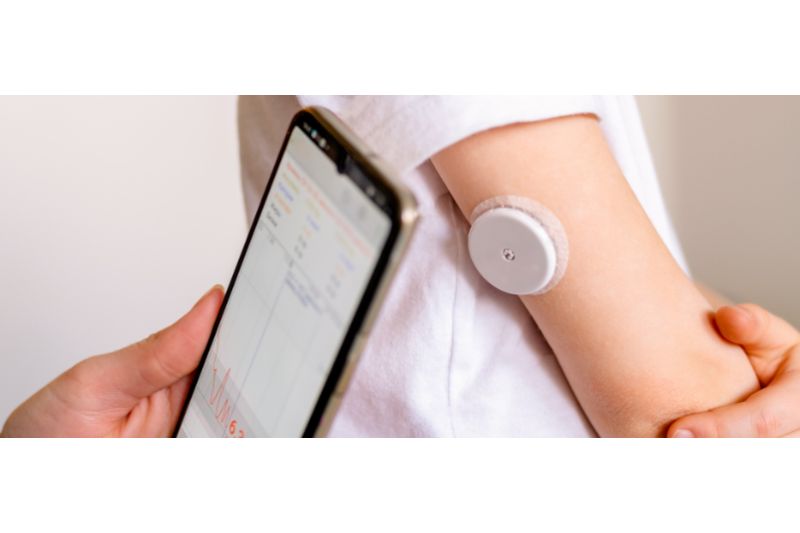For individuals living with diabetes, maintaining healthy blood sugar levels is a constant balancing act. Traditional finger-prick blood glucose meters provide snapshots of blood sugar at specific points in time. However, a revolutionary technology called Continuous Glucose Monitoring (CGM) is transforming diabetes management by offering real-time, continuous data on blood sugar fluctuations. This comprehensive guide explores the benefits of CGM, its functionalities, and how it empowers individuals with diabetes to take control of their health.
Beyond Snapshots: Unveiling Blood Sugar Trends with CGM
Unlike traditional blood glucose meters, CGM systems provide a continuous stream of blood sugar data over time. This real-time information allows you to:
- Visualize Blood Sugar Trends: CGMs display a graph of your blood sugar levels over time, revealing patterns and fluctuations you might miss with finger-prick tests alone.
- Identify Early Warning Signs: CGMs can alert you to trends that may lead to hyperglycemia (high blood sugar) or hypoglycemia (low blood sugar) before symptoms arise, allowing for timely intervention.
- Gain Insights into Food Response: CGMs can help you understand how specific foods and meals impact your blood sugar levels, allowing for more informed dietary choices.
- Optimize Exercise Strategies: Real-time data from CGMs can guide exercise routines by showing how activity affects your blood sugar and allowing adjustments to prevent hypoglycemia.
- Reduce Blood Sugar Monitoring Anxiety: By providing continuous data, CGMs can alleviate the anxiety associated with frequent finger pricks.
How Does CGM Work? Technology for Enhanced Management
CGM systems consist of two main components:
- Sensor: A small, thin sensor is inserted under the skin, typically in the abdomen or arm. The sensor measures glucose levels in the interstitial fluid (fluid between cells) every few minutes.
- Transmitter: Worn on the body near the sensor, the transmitter wirelessly transmits the glucose data to a receiver or smartphone app.
Different Types of CGM Systems: Choosing the Right Fit
Several CGM systems are available, each with its own features and functionalities:
- Real-Time CGMs: These systems continuously display glucose levels and offer customizable alerts for high and low blood sugar thresholds.
- Intermittent Scanning CGMs: These require scanning the sensor with a receiver or smartphone to obtain the latest glucose reading. However, some offer continuous data display on compatible devices.
- CGMs with Integrated Pumps: These advanced systems combine CGM technology with insulin pumps, allowing for automated insulin delivery based on real-time blood sugar data (closed-loop systems).
Benefits Beyond Blood Sugar: A Holistic Approach to Diabetes Management
The advantages of CGM extend beyond just blood sugar monitoring:
- Improved Glycemic Control: Studies have shown that CGM use can lead to better average blood sugar levels (HbA1c) and a reduction in blood sugar variability.
- Reduced Hypoglycemia Risk: Real-time alerts allow for proactive measures to prevent hypoglycemia episodes.
- Enhanced Sleep Quality: With CGM data, you can adjust medications or food intake to minimize blood sugar fluctuations during sleep, promoting better sleep quality.
- Increased Confidence and Freedom: Having real-time data empowers individuals with diabetes to participate more actively in managing their condition, leading to increased confidence and freedom in daily activities.
- Improved Quality of Life: CGM can significantly improve overall quality of life by reducing the burden of diabetes management and allowing for greater flexibility and control.
Considerations and Cautions: Understanding CGM Limitations
While CGM offers numerous benefits, it’s important to understand its limitations:
- Sensor Accuracy: CGM sensors require calibration with traditional finger-prick tests to ensure accuracy.
- Cost: CGM systems and supplies can be expensive, and insurance coverage may vary.
- Sensor Discomfort: Sensor insertion can cause mild discomfort, and some individuals may experience skin irritation.
- Technical Challenges: CGM systems require charging and may experience occasional technical glitches.
Beyond Technology: Building a Support System for Successful CGM Use
Getting the most out of your CGM requires a holistic approach:
- Consult Your Healthcare Team: Discuss if CGM is right for you and work with your doctor to integrate it into your diabetes management plan.
- Learn and Understand: Educate yourself on CGM technology, data interpretation, and how to adjust your lifestyle based on the information provided.
- Develop Problem-Solving Skills: Learn how to troubleshoot technical issues and address sensor insertion challenges.
- Manage Your Expectations: CGM is a tool, not a cure. It requires ongoing effort and adjustments to maximize its benefits.
A Look to the Future: Advancements in CGM Technology
The field of CGM technology is constantly evolving. Here’s a glimpse into potential future advancements:
- Minimally Invasive and Painless Sensors: Research is underway to develop sensors that are even less invasive and painless to insert, improving user comfort.
- Improved Sensor Accuracy: New sensors with enhanced accuracy will reduce the need for frequent calibration with finger pricks.
- Integration with Artificial Intelligence (AI): AI-powered CGM systems could analyze data to predict blood sugar trends and personalize insulin delivery for optimal control.
- Non-invasive Glucose Monitoring: Researchers are exploring technologies like sweat sensors or microwave technology for non-invasive blood sugar monitoring, eliminating the need for sensors under the skin.
- Closed-Loop Systems with Advanced Algorithms: Closed-loop insulin pump systems with more sophisticated algorithms will further automate insulin delivery based on real-time CGM data, simplifying diabetes management.
The Power of Choice: Empowering Individuals with Diabetes
CGM is a powerful tool that can revolutionize diabetes management. However, the decision to use CGM is a personal one. Discuss the pros and cons with your healthcare team to determine if it aligns with your needs and preferences. There’s no one-size-fits-all approach to diabetes management.
Conclusion:
CGM technology represents a significant leap forward in empowering individuals with diabetes to take control of their health. By providing real-time data and insights, CGMs allow for proactive management, improved blood sugar control, and a better quality of life. With continued advancements in this technology, the future of diabetes management looks brighter than ever. Remember, knowledge is power. Embrace new technologies like CGM, work with your healthcare team, and take charge of your diabetes journey!

 Diabetology1 week ago
Diabetology1 week ago
 Diabetology6 days ago
Diabetology6 days ago
 Diabetology1 week ago
Diabetology1 week ago
 Diabetology1 week ago
Diabetology1 week ago
 Diabetology4 days ago
Diabetology4 days ago
 Diabetology4 days ago
Diabetology4 days ago
 Diabetology2 days ago
Diabetology2 days ago
 Diabetology2 days ago
Diabetology2 days ago











